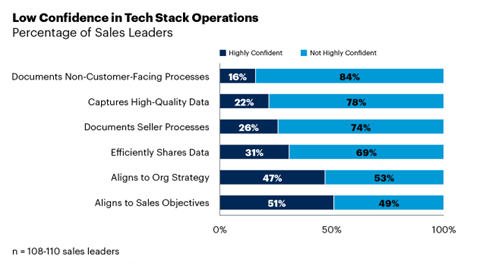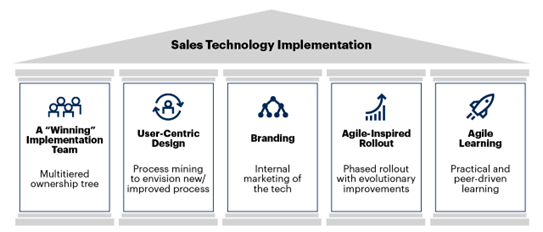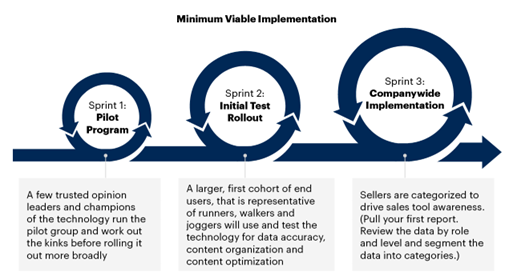
Webinar: Tuesday, April 29th @1pm
Winning at Retention-
Proven Strategies to Reduce Cancellations, Winback Customers & Drive Lifetime Value
Sign up Now

Sales has a technology adoption problem. Because salespeople often resist new tech (for lots of reasons), rollouts often suffer low adoption and fail to drive desired outcomes – namely, higher sales numbers.
A recent Gartner study of 908 B2B salespeople shows that nearly 60% reported the introduction of new sales technologies generally hinders their overall efficiency. That’s because often sales technology fails to meet the detailed daily needs of salespeople – or is “enterprise centric” rather than “seller centric.”
Sales leaders are feeling the pain themselves, too (see Figure 1).
Figure 1. Sales Leaders Have Low Confidence in Their Tech Stacks

To maximize the value of sales tech investments, sales leaders need to view technology implementation in a new light – namely, like a product. Leverage well-known product strategy principles across five key pillars (see Figure 2) to drive rep adoption and support the sales organization’s larger goals.
Figure 2. The Five Pillars of Treating Tech Implementation Like a Product

Sales tech implementations go beyond the simple acquisition of new technology and serve as fundamental change within the sales organization. Even when well designed and documented, questions will still arise, issues will pop up, and some measurement around the change outcomes will be expected over time.
Just like all other organizational changes, effective technology change begins with an implementation team that:
A common mistake when introducing new technology is that program managers overlook implications on the sales process and jump right into the technology’s functions and features. As shown in Figure 1, sales leaders lack confidence that their tech stack meets sales objectives: 84% are not confident that their tech stack documents non-customer-facing processes.
Accepting the fact that the introduction of a new technology is (first and foremost) a process change is required for proper technology adoption. Business owners and program leads need to process mine and visualize how the technology will either introduce a new process that will help end users or improve an existing process. Define that new or improved process, pinpoint the problems being solved, and identify every end-user group affected.
Next, identify how the product will influence salesperson experience. When designing for end users, the standard principles of UX also apply to sales tech implementation. Consider these five points when evaluating user actions within the technology interface:
The art of a sales tech implementation is using effective communications to pique the interest of salespeople and sales leaders to try adopting the technology. If the tone for “why” salespeople should adopt tech is rigid and compelling, so will the acceptance of using the tech.
Harness the power of branding to increase the demand for the sales tech implementation across all stakeholders.
One tactic to do so is leveraging the marketing principle of the “From/To/Because” model – an essential framework in change communications to help employees navigate a change journey. We learn best when we can acknowledge where we are currently, what the future state is, and why something is important – all components the model hits on.
Other tips in communicating the sales tech change story include:
Embracing agile principles in adoption of new sales technology presents an intriguing possibility of treating the technology implementation like a product in itself. Continuous end-user collaboration ensures superior user satisfaction with the technology and thus greater adoption. For the implementation team, agile offers unparalleled flexibility as they work on smaller sprints and are supplemented by constant user feedback – drastically reducing the risk of user rejection.
The key attributes of an agile-inspired technology implementation can be found in Figure 3.
Figure 3. Agile-Inspired Technology Rollout

To address emerging skill needs as well as drive home the true value of the new tech, sales leaders need to reimagine learning and free it from obsolete attitudes and methods.
Agile learning for sales is a mindset and method of skills development through the work, via iterative short bursts, applied in the flow of deals that can dynamically adjust with changing needs. It embodies four core values: 1) business outcomes over knowledge gained; 2) growth mindset over current skill set; 3) practical training content is real time and embedded on the job; and 4) peer-driven community learning over individual practicing.
Dan Gottlieb is a senior director analyst in the Gartner for Sales Practice. He covers a spectrum of topics across revenue technology strategy and pipeline generation.
Get the latest sales leadership insight, strategies, and best practices delivered weekly to your inbox.
Sign up NOW →